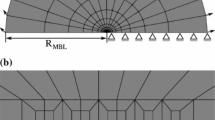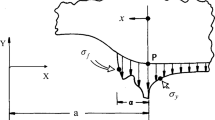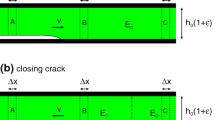Abstract
A theory of crack propagation, resulting from the application of a monotonic increasing applied stress, in a linear viscoelastic material, is derived based upon an energy balance fracture criterion. It is shown that for a Maxwell solid the crack growth law can be derived either from a global energy balance taking full account of the energy dissipation resulting from viscoelastic flow, or from a local energy balance taking account of the dissipation in the failure zones. The local energy balance method allows the derivation of the crack growth law for more general linear viscoelastic solids. The theory predicts the well known Griffith condition for fracture when the material is simply linear elastic. For a crack having failure zones in a linear viscoelastic solid the growth law for a constant applied stress is where c(t) is the time dependent half-crack length, 641-1 is the yield or crazing stress in the failure zone, K(t) is the time dependent stress intensity factor, Γ is the fracture energy, ν is Poisson's ratio and J(t) is the uniaxial creep function of the viscoelastic material. This growth law is valid if either J(t)≡0 for all times t>0 (i.e. a Maxwell solid) or if 641-1 641-2 641-3
Résumé
Une théorie de propagation d'une fissure résultant de l'application d'une contrainte monotonique croissante dans un matériau linéaire viscoélastique est dérivée sur la base d'un critère d'équilibre d'énergie de rupture. On montre que, pour un solide de Maxwell, la loi de croissance d'une fissure peut être déduite soit d'un équilibre global de l'énergie tenant complètement compte de la dissipation de l'énergie qui résulte de l'écoulement viscoélastique ou d'un équilibre local de l'énergie tenant compte de la dissipation de l'énergie dans les zônes de rupture. La méthode de l'équilibre d'énergie locale permet de dériver une loi de croissance de la fissure pour des solides viscoélastiques linéaires de caractère plus général. La théorie prédit la condition bien connue de Griffith pour la fracture dans le cas d'un matériau de linéarité élastique simple. Dans le cas d'une fissure qui présente des zônes de rupture dans un solide viscoélastique, la loi de croissance pour une contrainte appliquée est fournie. Dans cette loi, c(t) est la longueur de la demi-fissure dépendant du temps, 654-1 est la limite élastique dans la zône fissurée, K(t) est le facteur d'intensité de contrainte dépendant du temps, Г est l'énergie de rupture, ν est le module de Poisson et J(t) est la fonction uniaxiale de fluage dans le matériau viscoélastique. Cette loi de croissance est valable pour des conditions particulières de J(t).
Similar content being viewed by others
References
W.G. Knauss, Proceedings of the 1st International Congress on Fracture, Sendai, Japan (1965).
M.L.Williams, International Journal of Fracture Mechanics, 1 (1965) 292.
G.P.Cherepanov, PMM, 31 (1967) 503.
M.L.Williams, Journal of Applied Physics, 38 (1967) 4476.
J.R.Willis, Journal of Mechanics and Physics of Solids, 15 (1967) 229.
G.N.Savin and A.A.Kaminsky, Prikl. Mech. 3 (1967) 33.
G.P.Cherepanov, International Journal of Solids and Structures, 4 (1968) 811.
M.L.Williams, International Journal of Fracture Mechanics, 4 (1968) 69.
G.A.C.Graham, Quarterly of Applied Mathematics, 27 (1969) 497.
W.G.Knauss, Transactions of the Society of Rheology, 13 (1969) 291.
M.P.Wnuk, British Journal of Applied Physics, 29 (1969) 1245.
W.G.Knauss, International Journal of Fracture Mechanics, 6 (1970) 7.
B.V.Kostrov and L.V.Nikitin, Archiwum Mechaniki Stosowanej, 22 (1970) (in English) 749.
W.G.Knauss and H.Dietman, International Journal of Engineering Science, 8 (1970) 643.
M.P.Wnuk and W.G.Knauss, International Journal of Solids and Structures, 6 (1970) 995.
H.K.Mueller, International Journal of Fracture Mechanics, 7 (1971) 129.
H.K.Mueller and W.G.Knauss, Journal of Applied Mechanics, series E, 38 (1971) 483.
G.N.Savin and A.A.Kaminsky, Prikl. Mech., 7 (1971) 1.
C.Atkinson and R.D.List, International Journal of Engineering Science, 10 (1972) 309.
J.G.Williams, International Journal of Fracture Mechanics, 8 (1972) 393.
C.Atkinson and M.L.Williams, International Journal of Solids and Structures, 9 (1973) 237.
M.P.Wnuk, Journal of Applied Mechanics-Transactions ASME, 41 (1975) 234.
P.N.Kaloni and R.Smith, International Journal of Solids and Structures, 10 (1974) 1125.
G.P.Cherepanov, Mechanics of brittle fracture, (Nauka) Moscow (1974) 1–640.
R.A.Schapery, International Journal of Fracture, 11 (1975) 141.
R.A.Schapery, International Journal of Fracture, 11 (1975) 369.
A.A.Griffith, Philosophical Transactions of the Royal Society, A221 (1920) 163.
D.S.Dugdale, Journal of Mechanics and Physics of Solids, 8 (1960) 100.
N.Mills, Engineering Fracture Mechanics, 6 (1974) 537.
B.A.Bilby, A.H.Cottrell and K.H.Swinden, Proceedings of the Royal Society of London, A272 (1963) 304.
I.N.Sneddon and M.Lowengrub, Crack problems in the classical theory of elasticity, SIAM series in Applied Mathematics, Wiley, N.Y.-London (1969).
A.E.H. Love, A treatise on the mathematical theory of elasticity, Cambridge University Press (1920).
L.N.McCartney, International Journal of Fracture, 12 (1976) 273.
R.M.Christensen and P.M.Naghdi, Acta Mechanica, 3 (1967) 1.
Author information
Authors and Affiliations
Rights and permissions
About this article
Cite this article
McCartney, L.N. Crack propagation, resulting from a monotonic increasing applied stress, in a linear viscoelastic material. Int J Fract 13, 641–654 (1977). https://doi.org/10.1007/BF00017297
Received:
Revised:
Issue Date:
DOI: https://doi.org/10.1007/BF00017297




